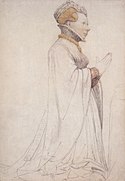Jana z Boulogne
| Jana z Boulogne | |
|---|---|
| vévodkyně z Berry a hraběnka z Boulogne a Auvergne | |
 Jana z Boulogne (nákres sochy z katedrály v Bourges od Hanse Holbeina ml.) | |
| Narození | 1378 |
| Úmrtí | 1424 |
| Pohřbena | katedrála v Bourges |
| Manželé | Jan z Berry Jiří z La Trémoille |
| Otec | Jan II. z Auvergne |
| Matka | Eleonora z Comminges |
| Některá data mohou pocházet z datové položky. | |
Jana z Boulogne či také Jana z Auvergne (francouzsky Jeanne de Boulogne, 1378 – 1424) byla vévodkyně z Berry a hraběnka z Boulogne a Auvergne. Do dějin se zapsala svou pohotovostí, když při smutně proslaveném bále světlušek zachránila život krále Karla VI.
Život
Narodila se jako jediná dcera a dědička Jana z Auvergne a Eleonory, dcery hraběte z Comminges. Část dětství strávila na dvoře hraběte z Foix, odkud roku 1389 přišla do Paříže a v červnu se provdala za téměř padesátiletého králova strýce Jana z Berry. Její majetek, byla považována za nejbohatší dědičku té doby, pomohl vévodovi pokračovat v jeho nákladných zálibách. Mladá vévodkyně ovdověla roku 1416 a v listopadu téhož roku se provdala za Jiřího z La Trémoille. I toto manželství zůstalo bezdětné. Jana zemřela roku 1424 a byla pohřbena v Bourges. V současnosti je její klečící socha umístěna v místní katedrále sv. Štěpána.
Externí odkazy
 Obrázky, zvuky či videa k tématu Jana z Boulogne na Wikimedia Commons
Obrázky, zvuky či videa k tématu Jana z Boulogne na Wikimedia Commons
Média použitá na této stránce
Jean de Boulogne, Duchess of Berry, study of a sculpture by Jean de Cambrai. Black and coloured chalk, 39.6 × 27.5 cm, Kunstmuseum Basel. Holbein drew this picture and its companion piece, Jean de France, Duke of Berry, during a visit to France in 1523/24, where he was probably seeking work with Francis I of France. The two sculptures drawn by Holbein were life-sized limestone effigies of Jean, Duke of Berry (1340–1416), and his second wife, Jeanne de Boulogne (1378–1424). At that time, the sculptures were in the chapel of the duke's palace in Bourges; they are now in Bourges Cathedral. Holbein's drawings were used as guides during a restoration of the statues, when 19th-century additions were removed. The two drawings are significant for Holbein scholars in providing direct evidence of the artist's visit to France and as the first example of his exclusive use of coloured chalks. He may have adopted the technique after seeing the drawings of Jean Clouet and other artists of the French school. However, he had already used chalks in his silverpoint drawings, and the technique was not unknown in Augsburg and Basel, where he practised his art. (Müller in Christian Müller; Stephan Kemperdick; Maryan Ainsworth; et al, Hans Holbein the Younger: The Basel Years, 1515–1532, Munich: Prestel, 2006, ISBN 9783791335803, pp. 316–17).
